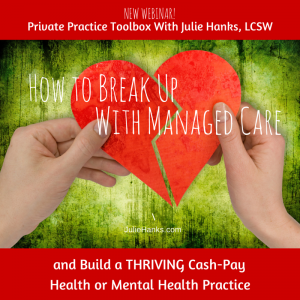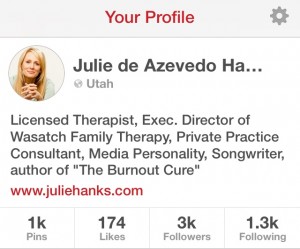Building a fee-for-service practice can be scary, especially if it means resigning from insurance panels and finding other ways to attract clients. Others may have already made the switch, but don't know how to successfully navigate the change. I have found some strategies to help ease the transition. Here are 5 common barriers to building a fee-for-service practice and ways to overcome them: 1) "I'm uncomfortable marketing myself"
I often hear therapists say that marketing themselves feels like bragging or tooting their own horn by self-promoting. In order to move past this barrier, it's helpful to reframe the way you think about marketing. Consider it instead as REST: Relationships, Educating, Serving, and Trust Building. You are building relationships with potential clients who might see your website or other media, you're serving your community by educating them about important topics related to your niche, and you're establishing rapport and building trust with those who encounter you through your (online) content (REST is essentially why you're in the profession in the first place, right?). If you can focus on these 4 things, you can (and will!) attract clients who will pay your full fee. While your "marketing" strategy (I'm not a fan of that word, by the way) REST strategy is meant to benefit you by helping your community become familiar with you and your services, it's really about those who you can potentially help through receiving services through your practice. Don't be shy in getting the word out about yourself; it's a way for you to use your professional skills to serve and educate your community.
2) "I'm afraid of the ethical issues surrounding social media"
Those new to the world of social media may be wary to fully embrace it because of the potential ethical problems that may arise. Potential for unethical dual relationships, confidentiality concerns, and lack of knowledge are common fears. But these fears (and others) can be overcome: having an official social media policy included with your intake packet, avoiding directly soliciting your additional products or services to existing clients, being familiar with privacy settings online, and overall just using your ethics training and common sense will help you be prepared to face these potential issues.
Click here to read a more comprehensive article about overcoming fears associated with social media.
3) "I'm not good with technology"
The internet gives us incredible opportunities to communicate and reach an audience that is unprecedented in size. However, for those unfamiliar with all the ins and outs, it can also be intimidating, overwhelming, and frustrating to start. Mari A. Lee, an LMFT who specializes in sex addiction recovery, understands this feeling all too well. She describes being scared and resistant to learning new technologies. But she was able to overcome her "technophobia" by starting with manageable goals, finding a patient and persistent mentor, asking lots of questions, and setting aside time to devote to learning and practicing new tech skills. Her success in building an online presence paid off big time; she's currently a best-selling author! "If I can figure out how to blog, attend and facilitate webinars, host online trainings, navigate my Facebook business page, and so forth, anyone can... If this 52 year-old former tech scaredy cat can do it, so can you!" Mari explains (read more about her experience here).
Understanding and applying the language of technology does not happen overnight. Be patient with yourself, as there's certainly some trial-and error learning here. Remember that everyone starts somewhere. And just like Mari, look for a mentor to guide you and bounce ideas and questions off of. You've proven yourself to be an apt and competent learner by becoming a licensed therapist; have the courage to learn another skill set as well.
4) "I can't do media appearances or speaking engagements because I hate seeing and hearing myself"
Therapists tend to get shy about media interviews. It's one thing to sit in front of a client and offer counsel in a one-on-one session, but speaking in front of large audiences can bring out anxiety in even the most confident clinicians. But remember how much you know; you are a trained and experienced expert. The aesthetic and "performance" aspect of media appearances will come with time. The more prepared you are, the more comfortable and relaxed you'll be. And if by chance you do feel like you bombed a television interview or radio podcast, learn from it and try to move on. It's not the end of the world if you make a mistake!
Read here for more tips on how to look good and sound professional in your media appearance.
5) "If I'm a great clinician, my work will speak for itself"
Some therapists plan to rely on their hard-earned reputation as an excellent mental health professional to be their main source of client referral. They then focus solely on refining their clinical skills, as they don't see the need to engage with their community beyond private sessions. While referrals can be an effective strategy to build your clientele, depending on others in the field to refer to you should not be the only way you attract people to your services. The harsh truth is that there are a lot of excellent therapists who fail in developing a successful private practice. Everyone has to start somewhere, and it takes time and experience to gain a loyal following and individuals who actively seek you out.
You may find that by being persistent in building trust in you and your services over time will be the major benefit to the growth of your practice. Because we have worked hard to establish ourselves as trusted professionals by embracing social media and building our online presence, my practice, Wasatch Family Therapy, receives most of our referrals from Google searches. This is something I feel very grateful for, and it's largely due to the fact that I stopped participating on managed care panels and consequently had to work within the community to build trust directly with potential clients.
Embracing a private pay practice model brings more than a few questions, unknowns, and worries. But by using these strategies, you can overcome barriers and build a thriving practice.
Besides the obstacles presented in this article, another major reason why clinicians may be wary of switching to private pay involves how they think their clients will be affected. I address (and debunk!) these fears here.
Click here to view my webinar and learn more strategies and tips about breaking up with managed care!
Join my Private Practice Toolbox Facebook group and connect with 2800 therapists around the globe in 2 simple steps: 1) Click request to join the group and 2) Fill out this brief questionnaire before you'll be added to the group.Get practice tips and blog updates in your inbox.
Sign up for the Private Practice Toolbox Newsletter here.









As healers, we genuinely like to do our work. Guiding clients through the therapy process and seeing them make progress is why we do what we do. But if you're in private practice, you know there's a lot going on in the back end and that it's crucial to run an efficient and organized business.